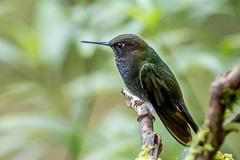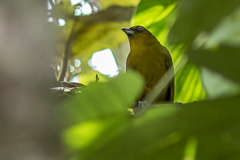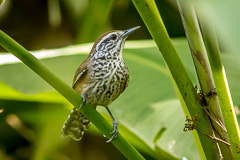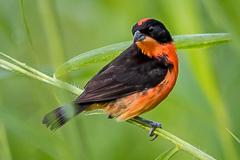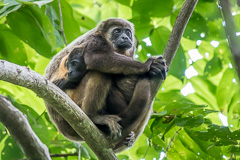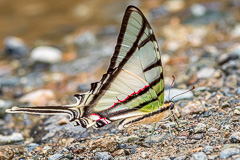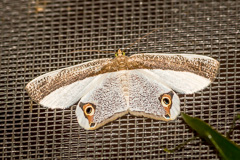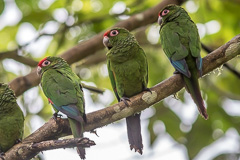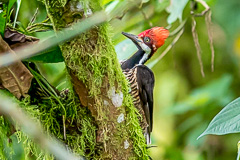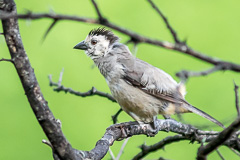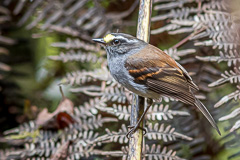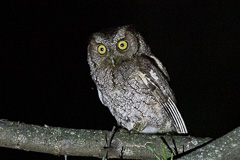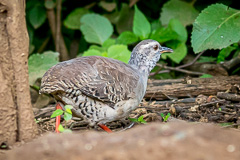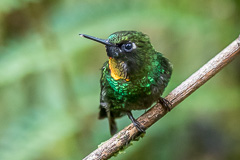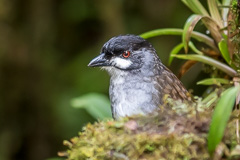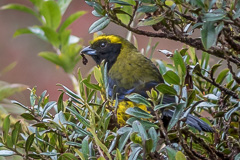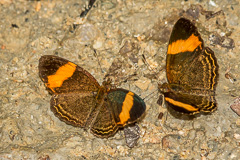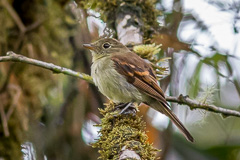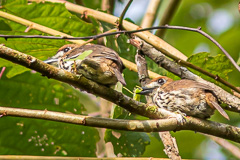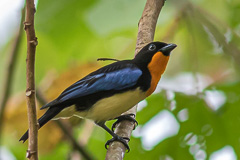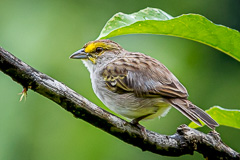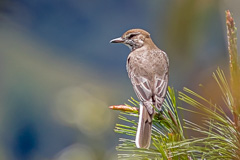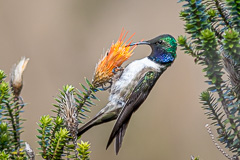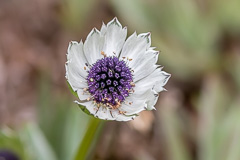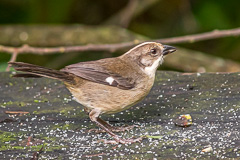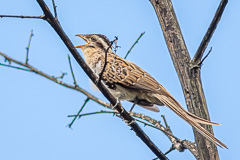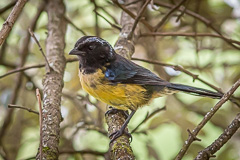Overview
Dates: |
13 Mar - 6 Apr 2022. |
With Mike Danzenbaker and Lee Hung. Due to the never-ending Covid saga, this trip was posponed from the originally planned date in 2021. As this meant coinciding with the rainy season, we anticipated wet weather and some potential landslide issues. Even shortly before the planned start, with the outbreak of the Omicron variant, we were unsure if the trip would actually happen, so delayed confirmation as long as possible. As in the 2019 trip, we teamed up with local guide Alex Luna. The itinerary was based on our combined target list, with timing primarily driven by a few key targets, particularly Esmeraldas Woodstar. The originally planned start from Guayaquil on 14 March was scuppered just a few days prior to departure, when KLM changed their schedules, resulting in no connection in Amsterdam. This necessitated starting two days earlier, and flying into Quito rather than Guayaquil, thus giving an opportunity for some short birding around Mindo. As with most other trips into the Neotropics, nearly all the places we stayed we would have liked to stay longer.
Itinerary
11 Mar. With Chiang Mai airport international terminal still closed two years into Covid, an evening domestic flight to Bangkok, for which neither vaccine certificate nor Covid test were requested. At the KLM check in at Bangkok staff insisted on a Covid PCR test certificate - even though the Ecuadorian government had abandoned this requirement mid February. Even showing the official notification of this from the Ecuadorian government website, the airline staff were not interested as "not according to our system". Fortunately, in anticipation of such an occurrence, a Covid test had been taken the previous day- one of the joys and risks of travelling at this crazy time.
12 Mar. After two, 100% packed, 12 hours flights, Bangkok - Amsterdam, and Amsterdam - Quito, finally arrived at 16:30, with a full 12 hour time difference from Bangkok. At Quito airport, health paperwork, immigration and customs were straightforward, though the queue at immigration was over 30 minutes. Collected by the pre-arranged local driver-guide Alex Toapanta and transported to Mindo, where very happily crashed out. 13 Mar. With Alex Luna not available until 15 March, two days were spent in the company of Alex Toapanta searching for a couple of target species around Mindo. First up was Hoary Puffleg, which after the previous trip's fiasco was high on the most wanted list. A morning visit to the feeders at Quinde Luna unfortunately failed to produce the bird, even though it had been visiting previously. Several hours produced a reasonable selection including Green Thorntail, Sickle-winged Guan, Empress Brilliant, Purple-throated Woodstar and Strong-billed Woodcreeper. By mid afternoon we decided to cut our losses and put our efforts into finding Blue Seedeater. However, en route to Mindo, Alex visited a friend who reckoned the puffleg was likely available at a private property some kilometres away. This proved highly fortuitous, and being able to arrange access at short notice we were finally able to put Hoary Puffleg to bed. Late afternoon we tried for Blue Seedeater around Mindo, but not being an optimal time of day, or year, we failed. Overnight in Mindo. 14 Mar. A two hour drive to the Mashpi Conservation Area. Our sole target was the scarce and localised Yellow-green Tanager. Despite the excellent weather, the first couple of hours was hard going, with few species and no feeding flocks, though we did manage fleeting looks at what was probably the tanager. During the morning and the early afternoon we tried several areas, finding Scaled Fruiteater, Purple-chested Hummingbird, Golden-winged Manakin, Slaty-capped Shrike-Vireo and Scarlet-and-white Tanager. In the heat of the day we returned to the first area and this time found a larger feeding flock, obtaining much better views of Yellow-green Tanager. Before departing back to Mindo we checked out a number of the impressive butterflies. |
15 Mar. An all day drive, with the two Alexes, from Mindo to Guayaquil, where met up with Mike and Lee arriving from USA. We encountered very heavy traffic in Guayaquil city, and having finally checked in to our city accommodation quite late, we then discovered that no food was available from either the hotel or nearby. However, we were too tired to care anyway.
16 Mar. We left at 05:30 in order to beat the rush hour. Stopping for a quick breakfast en route we arrived at Rio Ayampe Reserve around 08:30. Although we didn't stop to bird, as we drove north along the coast, we passed many pools and beaches, seeing a collection of waterbirds including Limpkin, Snail Kite, Roseate Spoonbill, Magnificent Frigatebird, and Grey-headed Gull. Our primary reason for visiting Rio Ayampe was the potential from December to April for finding Esmeraldas Woodstar, and we were fortunate to find two males within a couple of hours. Their minute size, scarcity and cool appearance made this one of our top targets. During the heat of the day we retired to a nearby, pleasant, beach resort, returning to the same trail for a few hours late afternoon. 17 Mar. A repeat visit to Rio Ayampe spending the morning in pursuit of several other targets. During our two days here we recorded around 80 species including Long-billed Hermit, Long-billed Starthroat, Blue Ground Dove, Grey-backed Hawk, Red-billed Scythebill, Tumbes Pewee, Superciliated Wren, Speckle-breasted Wren, Black-capped Sparrow and Orange-crowned Euphonia. After midday we returned to Guayaquil, stopping for a sumptuous seafood lunch near Santa Elena. Thus far, a great start to our trip. 18 Mar. Another early departure from Guayaquil, heading to Manglar Churute Reserve, where we arrived by 07.30. All morning was spent on the main loop trail inside the reserve, plus the dirt road running past. No sooner had we arrived than a pair of Crimson-breasted Finch popped up. Although the trail inside the forest was generally pretty quiet, two excellent species were found - Tropical Royal Flycatcher and Black-billed Cuckoo; the later bird having been a personal nemesis for the last 30 years. So it was great to finally lay that one to rest. Other species encountered included Pale-vented Pigeon, Jet Antbird, Ochre-bellied Flycatcher and Parrot-billed Seedeater. Plus one of the surprisingly few mammals of the trip; Mantled Howler Monkey. |
The final half hour was spent at the adjacent mangroves with a very smart Central American Boa, as well as a good number of butterflies around the entrance. The drive to Buenaventura took much longer than planned due to traffic, which delayed our arrival to 18:30. |
Since we were now firmly in the foothills of the western Andes the weather turned decidedly damp, with thick cloud persisting. As numerous moths attracted to lights around the lodge restaurant were stunning, we spent much time photographing them. Heavy overnight rain. 19 Mar. An early start in order to drive to the El Oro Parakeet nesting area, and hike uphill prior to the birds dispersing for the day. Although this species was not nesting at this time, some continue to roost in the nest boxes provided, so it was important to arrive prior to 07:00 when the birds start to move to the surrounding hills. During our couple of hours here a total of eight birds emerged from one of the boxes, giving us excellent close range views. Next, we continued to the other side of the valley, searching for the localised El Oro Tapaculo, which proved difficult and was barely glimpsed in the undergrowth. We then birded the road for three hours with a fair selection - Stripe-throated Hermit, Short-tailed Hawk, Russet Antshrike, Slaty Antwren, Uniform Treehunter, and Spotted Barbtail, as well as Plain-backed Antpitta heard. Lunch at the lodge was accompanied by a pair of Guayaquil Woodpecker at point blank range. We then set off birding the entrance road of the lodge, searching successfully for Ochraceous Attila, which we luckily encountered just before 16:00 when rain commenced, washing out the remainder of the day. Further moths at dinner, with a Black-and-white Owl calling nearby. 20 Mar. A slightly later start at 06:30, with the whole day birding the track above the lodge, including the Umbrellabird Trail, though we did not look for that species specifically, which was just as well since none was encountered. First up, we tried the steep Tropical Royal Flycatcher Trail, due to Rufous-fronted Wood Quail vocalising down-slope. No luck with those however, so we walked the road as far as the Umbrellabird Trail finding our top target, Slaty-winged Foliage-gleaner. After lunch the weather stayed dry enough to investigate higher up the track though nothing of note, save a couple of Speckled Tanager - a species rare in Ecuador. |
21 Mar. We spent the morning, eventually successfully, trying for better views of El Oro Tapaculo, followed by walking the same road as yesterday. After an early lunch we departed to El Empalme in search of White-headed Brushfinch, but no sooner had we arrived than with impeccable timing it started raining. A couple of hours here failed to locate the brushfinch, though we did run in to the rare Black-and-whie Tanager, which was a great bonus. Other interesting species included Ecuadorian Ground Dove, Croaking Ground Dove, Scarlet-backed Woodpecker, Baird's Flycatcher and Golden Grosbeak. We then completed the drive to Jorupe for our three night stay. Spectacled Owl was vocal around the cabins, plus plenty more moths to photograph.
22 Mar. A return to El Empalme for White-headed Brushfinch which, with the help of Leo, one of the staff from Jorupe, we found relatively quickly. With this key species now found, we returned to Jorupe to bird the entrance road. A vocal Grey-capped Cuckoo gave us a complete run-around, with us crawling through undergrowth for 90 minutes, staring into thick foliage and seeing absolutely nothing - not even a branch moved. We then birded the road and trails for the remainder of the day. Two targets, Ochre-bellied Dove and Watkins's Antpitta, were heard only, but others of interest included Black-billed Cuckoo again, Rufous-necked Foliage-gleaner, Blackish-headed Spinetail, Collared Antshrike, Grey-breasted Flycatcher, Sooty-crowned Flycatcher and Slaty Becard. |
After dinner we tried for Buff-fronted Owl which we heard at a reasonable distance, but were unable to approach due to the steep terrain and dense undergrowth. A somewhat frustrating end to the day, but given the notoriety of this owl, no surprise.
23 Mar. This morning, again with the help of Leo, we covered a number of sites scattered between Jorupe and Utuana, starting at a small village square where, under the eaves of the church and surrounding houses, we watched a good number of Chestnut-collared Swallow nesting. During the morning we visited various forest and scrub remnants between altitudes of 1,200 - 2,700 metres. Grey-headed Antbird proved tricky and time-consuming, then a number of spots were searched for Jelski's Chat-Tyrant. Returning to the lodge, we then drove the dirt road toward Cerro Chuqui, mainly in search of Andean Slaty Thrush, but which proved elusive. We did however, obtain good views of Watkins's Antpitta, Elegant Crescentchest, Chapman's Antshrike, White-winged Brushfinch and Yellow-tailed Oriole. Following dinner we repeated our Buff-fronted Owl hunt. Our first attempt was naturally at the same area as we'd heard the bird yesterday, where we'd even employed a local youth to clear a trail into the forest. This was indeed a fine trail which gave us easy access to the area, but the bird was silent or missing - very disappointing. In desperation we tried a kilometer farther up the road, which initially seemed dead, but then after 30 minutes a bird started calling occasionally. However, after yet another hour staring into the tree tops we were again beaten by the terrain and vegetation. The only consolation was a Peruvian Screech Owl nicely posed. 24 Mar. Our morning was spent along the entrance road at the lodge and a couple of trails in the vicinity. The best birds encountered were Grey-capped Cuckoo finally, and Blackish-headed Spinetail. Late morning we lucked into a Pale-browed Tinamou at the feeders. After an early lunch we left for Tapichalaca, stopping to try, unsuccessfully, for Puira Hemispingus en route, but the miserable damp and low cloud beat us. Due to the thick fog and difficult driving conditions, we did not arrive at Tapichalaca till 19:00. Our delays we also compounded by heavy rain in the mountains causing flash floods with sections of road turning to torrents of rock and mud, which required assistance from locals to clear, with heavy road and farm machinery. All in all an interesting journey! At 2,500 metres. conditions were cold and wet at the lodge. Talking to other visitors, conditions had been very poor all day. |
25 Mar. Dawn around the lodge was rather quiet, though Flame-throated Sunangel, was already at the feeders, and an Equatorial Antpitta hopped across the garden. The morning was then spent in a longish loop walk to the antpitta feeding area, then back along the highway. Although sodden and muddy underfoot, the weather at least was not raining. In total we were rewarded with three Jocotoco Antpitta; an adult before the feeding station and two immatures at point blank range once there. After an hour admiring these, we birded the remainder of the trail finding Bearded Guan, White-throated Quail-Dove, Golden-plumed Parakeet, Rusty-winged Barbtail, Chusquea Tapaculo, Orange-banded Flycatcher and Black-throated Tody-Tyrant. As we reached the highway, rain started in earnest, though fortuitously a disused hut provided shelter, and between the showers we managed Black-capped Tyrannulet and fleeting views of Rufous-capped Thornbill. Following lunch, in a bid to avoid the rain, we birded the roadside a thousand metres below the lodge. This proved slightly drier and, after considerable effort, gave us Chestnut-belled Thrush, Red-crested Cotinga and Chestnut-crested Cotinga, though we failed on Subtropical Pygmy Owl. Further rain into the evening. |
26 Mar. A wet and frustrating day, which was spent ploughing up and down the road from the lodge, trying to evade the fog and rain. The only one of our targets we ran into was good views of Rufous-capped Thornbill, but we failed to encounter Pale-footed Swallow, Chestnut-rumped Tyrannulet or Flammulated Treehunter, despite a lot of effort. We did however, have a major surprise in the form of a pair of Neblina Metaltail at higher altitude - a decided bonus, as this species can be very tricky. By 16:00 the rain set in, and after a couple of hours of seeing virtually nothing in the fog and drizzle, we called it quits and returned to the lodge.
27 Mar. We left early to drive to the summit of Cerro Toledo. At 3,200 metres the weather was much better than expected, being overcast and windy, and without the horizontal rain we'd been promised. The first bird heard was Loja Tapaculo, though we didn't spend time looking for it; having other priorities. For the next few hours we birding the track down to about 2,700 metres. Plumbeous Sierra Finch, Rainbow-bearded Thornbill and Many-striped Canastero were found, plus our main target, Masked Mountain Tanager, after an hour or so of searching. The long-threatening rain started at 11:00, after which we left to drive to Copalinga, arriving by 15:00. Our first bird, on climbing out the car, was Greenish Puffleg. Currently, Copalinga is the only known site where Grey Tinamou comes to feeders, so with some daylight remaining we headed out along the trail to the feeding station. Having put out some corn we waited. Although a couple of birds were calling nearby none came to feed, and it was only as we were preparing the leave that we suddenly saw a bird approaching from behind the hide. Evidently the bird had other ideas and failed to appear again, so at dusk we started back. However, we'd gone no distance when a roosting bird was found. This would appear to be an extremely rare sighting, with apparently no images of a perched bird anywhere. The familiar rain started by 18:00 and continued into the night. |
28 Mar. We started with the short drive to Podocarpus National Park. From the parking area it's a kilometre walk to the office and accommodation area, along what should a good birding trail. Although this morning was rather quiet, we did manager Wattled Guan, Lafresnaye's Piculet, Andean Motmot, Black-billed Treehunter, Ash-browed Spinetail, and poor views of Foothill Eleania. By midday a good number of butterflies were active in sunny areas along the trails. For an hour or so after lunch we birder the grounds and feeders around the lodge, finding Pale-tailed Barbthroat and Blue-fronted Lancebill. Mid afternoon we drove about 30 kilometres to a private garden where Spangled Coquette was alleged to appear regularly, but despite good weather and plenty of suitable flowers, it failed to put in an appearance. We then tried a local marsh for Uniform Crake, which was equally unsuccessful.
29 Mar. As we had a two hour drive to El Zarza we left the lodge at 05:00. An excellent start with Chestnut-tipped Toucan and Roraiman Flycatcher seen well, as well as the superb Telemachus Morpho butterfly.
In general the going was slow, and we struggled with many of our targets. Plus a couple of hours rain from 11:00 - 13:00 did not help. We did however luck into Equatorial Greytail at the end of the day, as well as picking up Napo Sabrewing, Coppery-chested Jacamar, Striped Treehunter and White-fronted Tyrannulet. |
We also heard Subtropical Pygmy Owl but, as ever, the call was very distant. A slower drive back to Copalinga due to the rain.
30 Mar. A repeat visit to Podocarpus. This time we managed much better views of Foothill Eleania, but not the distant White-necked Parakeet. The morning consisted of walking several of the trails around the park headquarters, after which we tried the vicinity of the lodge before the relatively short, two and a half hour drive, to Maycu.
Following the relative luxury of the Jocotoco lodges so far, the rustic Yankuam brought us back to reality, though to be fair, considering the location, this private lodge is comfortable enough, plus great birding on its doorstep. Often this area is strikingly hot, but was now cool and very damp. Our three days here turned into the wettest part of the trip. 31 Mar. Following heavy rain most of the night, we birding the road through the Maycu reserve. Generally, the birding was slow with frequent rain showers and low cloud. Consequently we spent much time guessing the identify of birds half lost in the fog. Most of the activity was restricted to a few feeding flocks, which included a couple of sightings of Orange-throated Tanager. The highlight of the day was undoubtedly a pair of Lanceolated Monklet. The small waterfall adjacent to the accommodation was good for butterflies in the middle of the day - showers permitting. 1 Apr. Morning again along the dirt road passing through the Maycu reserve, with much better views of Orange-throated Tanager, plus Amazonian Trogon, Purplish Jacamar, Red-stained Woodpecker, Chestnut-eared Aracari, Tschudi's Woodcreeper, Duida Woodcreeper, Brown-billed Scythebill, Bamboo Foliage-gleaner, Rufous-tailed Foliage-gleaner, Ornate Stipplethroat and Spot-winged Antbird. During the afternoon we explored open habitats beyond the reserve, picking up Dark-breasted Spinetail, Black Antbird and Hairy-crested Antbird. Amazingly, given the somewhat remote location, we discovered a village shop selling ice cream. And very tasty it was too. 2 Apr. Overnight rain continuing into the morning effectively knocked out our plans to walk a trail into the surrounding hills in pursuit of higher elevation species. So we ended up birding a different section of the reserve, but the cold, damp, conditions meant almost no birds found. A brief interlude in the rain from 9:30 - 10:00 gave us Amazonian Umbrellabird, Swallow Tanager, Olive-faced Flatbill, Chestnut-crowned Becard and Magpie Tanager. We left the area shortly before 13:00 for the five and half hour drive to Saraguro town. |
3 Apr. A slightly late departure following a bit of a faff with the packed breakfast not materialising as promised. Then left for the hour drive to Cerro Acanama, climbing the dirt road into the hills up to 3,200 metres. The main target here was Chestnut-bellied Cotinga, with this mountain being just about the only site where this bird is accessible in Ecuador. We were not that optimistic however, as we knew the bird had not been found for a few months. So it was a great relief that after a couple of hours searching we located a pair. With the weather remaining dry throughout the morning we managed a good haul of species, including Golden-crowned Tanager, Blue-backed Conebill, Brown-backed Chat-Tyrant, Mouse-coloured Thistletail, Great Sapphirewing and White-tailed Shrike-Tyrant. 4 Apr. Unbelievably, another faff waiting for the packed breakfast. Evidently, despite birders using this hotel regularly, the early departures had not sunk in with the staff. It's a near three hour drive to Cerro de Arcos, and the poor dirt road, up to 3,700 metres, is decidedly not for a two-wheeled mini-bus like we were using. Hats off to Alex for his skill behind the wheel in getting us up there, with several patches that looked extremely difficult to navigate. Fortunately the weather was good and we found the recently described Blue-throated Hillstar without too much effort. Part of this upper portion of Cerro de Arcos has set up to protect the few known pairs of the hillstar, but although fenced to keep out domestic animals and preserve the native habitat, we found both horses and cows crazing on the native vegetation. Clearly this species has a dim chance of long term survival, and much paramo was being cleared to plant pines. For the remainder of the morning we birded the paramo, finding Andean Teal, Purple-throated Sunangel, Black-tailed Trainbearer, Rainbow-bearded Thornbill, Aplomado Falcon, Chestnut-winged Cinclodes, Many-striped Canastero and Paramo Ground Tyrant. Once down the mountain, a longish drive, along a very scenic route, to Santa Isabel, arriving at 19:00. In a spate of madness we then decided to try for Buff-fronted Owl in the hills above town. |
This turned into a something of a slog along muddy trails, followed by us attempting to drive down another unsuitable track for our vehicle, with Alex having to reverse the vehicle, in the dark, over a makeshift bridge along a road of mud, and turning the vehicle around on a mud slope. Amazingly he didn't slip off the road, as we'd almost envisioned spending the night there. Well done Alex again. Sadly we didn't even hear the owl.
5 Apr. A short drive above the town to Yunquilla Reserve, where we met one of the local rangers, who escorted us to the feeders. Of course the top target here is Pale-headed Brushfinch, and through the morning we saw several. Also present at the feeders were Chestnut-crowned Antpitta, Golden Grosbeak and Grey-browed Brushfinch. The remainder of the morning was spent along the main trail and the road immediately outside the reserve, finding Purple-collared Woodstar, Turquoise Jay, Scrub Blackbird and Black-lored Yellowthroat. In the heat of the day we birded the opposite side of valley to the reserve, but finding little, we suddenly had an impulse to try the area around San Gerado, where Tawny-rumped Tyrannulet had recently been recorded. A couple of hours here late afternoon was surprisingly successful, especially since we had no specific details. So we finally caught up with this widespread but scarce species which had been bugging us the whole trip. Due to the heavy traffic in Cuenca city we arrived later than planned, as our hotel was located in the very centre of this pleasant, old city. 6 Apr. News of the main highway to Guayaquil being blocked by landslides meant that we'd have to take a much longer return route for our evening flight. Even worse, landslides were also blocking access to Cajas National Park, and the usual sites for our sole remaining target; Purple throated Metaltail. Fortunately Alex was able to set up a short morning birding session with a local guide who reckoned the metaltail was possible elsewhere, but no promises. Setting off at 06:00, the driving was not congested, so we arrived at our first birding spot at 3,000 metres within 45 minutes. Fortuitously, this provided us with short views of a single Violet-throated Metaltail. Suitably relieved, we then had the next few hours trying higher altitudes, with the expectation of further sightings. This proved not to be though, and despite the efforts of our guide, we never found another. Just to reinforce how lucky we'd been, a revisit to the same initial locality failed to find the bird a second time. By 10:30 we ran out of time and returned to the hotel for a hurried breakfast, to pack and hit the road. |
Following a five hour drive to Guayaquil we said our goodbyes to both Alexes, and headed to the Covid test facility at the airport. This was quick and relatively inexpensive at $30 per test. Fortunately we all passed and were able to board our evening flights to Quito and beyond. All in all a highly successful trip with most targets found, plus a few additional surprises along the way. Of course, as always, a few dips - most painful of which no doubt being Buff-fronted Owl. But we'll be back to sort that one out eventually.
Species List
Galleries
Bird images from this, and other, birding trips.
Travel images from this, and other, birding trips.

